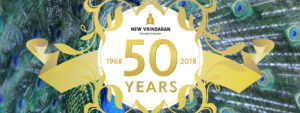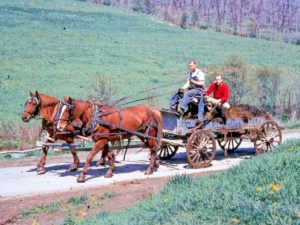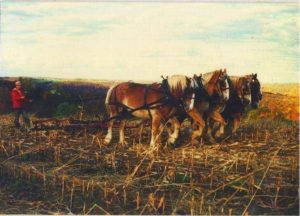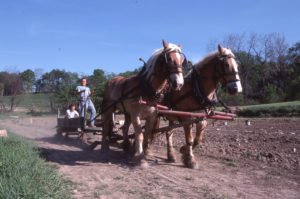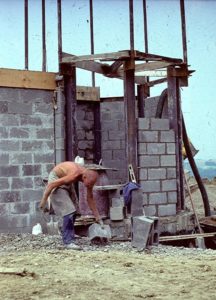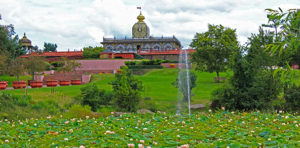NEW VRINDABAN DAYS – CHAPTER 8
NEW VRINDABAN DAYS
As New Vrindaban enters its 50th anniversary (1968 to 2018), I wrote this series of articles for the Brijabasi Spirit in an attempt to give the reader not only an “understanding,” but more importantly a “taste,” of what life in early New Vrindaban was like – through the stories of one devotee’s personal journey.
The title of the series, “New Vrindaban Days,” is in tribute to the wonderful book “Vrindaban Days: Memories of an Indian Holy Town” written by Howard Wheeler, Hayagriva Dasa. He was one of Srila Prabhupada’s first disciples, a co-founder of New Vrindaban, and, a great writer. As with Hayagriva’s book, this series focuses on a period of time in the 1970’s.
I would also like to acknowledge and thank Chaitanya Mangala Dasa, for spending untold hours assisting me in refining my writing for your reading pleasure.
I have been asked to describe certain aspects of early New Vrindaban Community life such as the nature of the austerities, what it was like for a new person coming here, cooking, anecdotes about particular devotees, etc.
I attempt to tell these stories in some semblance of a chronological order, beginning with my first meeting with devotees in 1968, leading to my arrival in New Vrindaban in late 1973 and carrying through to the official opening of Srila Prabhupada’s Palace in 1979.
Advaitacharya Dasa
CHAPTER EIGHT: PROPAGANDA
The year is 1974 and it’s my first time living in New Vrindaban. Everywhere I go there is talk about what New Vrindaban will be – “someday.” Someday – we will have a theme park replica of Krishna’s pastimes called Krishnaland. Someday – we will have a hand carved altar for Krishna made of the finest teak wood. Someday – people will visit from all over the world. Someday – there will be a Palace for Srila Prabhupada to live in.
The reality is we are penniless, we have very little to eat, we are in the middle of nowhere and we have no visitors. Very quickly I have come to believe all of the “somedays” are no more than propaganda meant to convince the feeble minded to stay.
When a ten foot blue print of a hand carved altar is hung up on the wall in the prasadam room for all of us to inspect, I am impressed at how far they will go to brainwash us.
I have been in New Vrindaban a matter of weeks. Despite the fact that I have burned down the community’s only source of income, the Swami seems to like me and I have quickly moved up the ladder from dragging mud, to cutting wood, to shoveling horse manure.
The head of the “plough” department is Paramananda Das, a senior devotee amongst the first that joined Prabhupada at the original Hare Krishna temple at 26 Second Avenue in New York. Paramananda is in his mid-thirties, making him much older than the younger devotees like myself. He and his family live up the road at the Madhuban farm. Paramananda is very nice to me, sometimes even taking me along when he visits local farmers he befriended.
During a conversation with Paramananda, in which I reveal that I am having trouble getting out of bed early in the morning to chant my rounds, I get a tidbit of advice that has stuck with me for over forty years.
“Have your wife prepare a bowl of fresh berries,” Paramananda says.
I am all ears.
“Pour some ice cold fresh cream over the berries,”
I’m transfixed.
“Sprinkle the berries and cream with several spoonfuls of sugar,”
I’m drooling.
“And then have her wake you up with that bowl of berries and cream right by your head.”
It is completely against any semblance of the “sense control” philosophy of the Hare Krishna movement, but he has painted the most succulent picture of an alarm clock and method of waking up I have ever heard.
Unfortunately for me, I have no access to berries, fresh cream, or sugar. Nor does it appear that I will at any time in the near future. Nonetheless, if I ever I find myself in need of a gentle way to wake a starving person out of a dead sleep, this is it.
Also working in the horse barn is Kasyapa Das (aka Varsana Swami), a brahmacari who every day makes the 3 mile walk from the ashram at the original Vrindaban farm to Bahulaban.
He is from New Jersey, not far from New York City where I am from. But, unlike me, Kasyapa is reserved, contemplative, and self-controlled. We are polar opposites. I talk constantly and Kasyapa seems most comfortable talking to the horses. At the time I do not know it but he is also the hardest working devotee in the community and trying to keep up with him is near to impossible. He is the first on the job, despite his three mile walk, and the last to quit at the end of the day.
In addition, he does not seem to need to eat. Even though seemingly all of the New Vrindaban residents meditate constantly on their next meal, it is not unusual for Kasyapa to take us on a long walk to an obscure field, in the middle of nowhere, with no intention of getting us back in time for lunch.
Sometimes we eat gnarly, wild crab apples found on an errant tree. Sometimes we don’t eat lunch at all. Growing up watching television in New York City there was a commercial for a Columbian coffee that plays up its mascot, the coffee bean buyer, El Exigente – The Demanding One. To me Kasyapa is – El Exigente!
It is on a Sunday morning, getting close to spring, when Kasyapa approaches me saying we will be going three miles up the road with the horses to do some work in one of the fields.
My mind catches fire immediately. “He can’t think we are going to miss the Sunday feast to work in some God-forsaken field, can he?”
No, I tell myself, afraid to ask him. He must have a couple of things to do in a small field and then we will return in time for the feast. We trudge the three miles up the state road, finally exiting into a forest.
When we come out on the other side of the woods I am looking at one of the biggest fields I have ever seen. My chest tightens, making it hard for me to breathe and my heart cracks at the realization we will most certainly be missing the feast. Besides the obvious frustration of the feast issue my mind becomes more disturbed as Kasyapa begins to explain the job at hand.
The field has been plowed at some time in the past and lies before us in torn up clumps of clay measuring about 1 ft. x 2 ft. each. Kasyapa leads me to a rusted piece of ancient horse drawn farming equipment called a “cultivator.” It lies close to the ground and is about 5 ft. x 6 ft. and has about four rows of spinning steel blades that are meant to cut through and break up the giant clumps of clay.
It sounds logical until Kasyapa hooks up the horses to it and begins pulling it across the field with me following behind them. The clumps are so hard that the blades have no effect and just bounce along the surface of the soil. Soon Kasyapa stops the team and ponders, before turning to me.
“Maybe you can stand on top of it to give it some added weight,” he suggests.
Standing on top of a rusted piece of equipment, that consists of not much more than fifteen whirling steel blades, doesn’t make a lot of sense to me, but Kasyapa is fairly confident I will not get killed. I climb up struggling to balance myself as he commands the horses to pull. Lucky for me, I do not get killed – or even fall off – but it doesn’t matter because my weight didn’t make any difference to the giant clay clumps.
Kasyapa is completely frustrated at the failure of our effort. I pretend to be just as disappointed but in reality I am internally rejoicing, thinking he will give up the folly of this effort and we will rush back to the temple so I can fill my face at the Sunday Feast.
“Follow me.” he says, walking the horses to the other end of the field where we find a tarp draped over a large pile. Kasyapa removes the tarp revealing a mountain of 50 pound bags of lime, which we will spread on the field after we get it cultivated.
“Help me with these bags.” he says, and we begin stacking them any place they can fit on the cultivator without hitting the steel discs. After stacking four or five hundred pounds of lime on board Kasyapa instructs me to sit on top of the bags and again commands the horses to go. This time we actually make a minor dent on the clay clumps before Kasyapa stops the team to give them a rest.
Sitting atop the lime bags, and pondering the vastness of the task before us, I peer through the treetops where my eyes come to rest on a lone cinder block wall across a valley, seemingly in the middle of nowhere.
“What is that?” I ask Kasyapa.
“That is Srila Prabhupada’s Palace,” he replies.
I am stunned. I stand on the pile of lime bags. “That’s Prabhupada’s Palace?”
“Yes,” he answers.
In that moment, I am blown away. It is really there. It is not propaganda. The devotees have actually built a fifty foot cinder block wall.
My mind reels. Someday – there will be a Palace for Srila Prabhupada to live in.
On that day, there would be no Sunday feast for me.
But, also on that day, standing in a field with Kasyapa, I got my first glimpse of “someday,” clearly visible on the New Vrindaban horizon.
—————————————————————————————-
Did you miss any of the previous chapters? Click the links below to catch up:
Chapter 1: Every Journey Begins With a Single Step
Chapter 2: Srila Prabhupada – Jaya Radha Madhava
Chapter 3: Captured by the Beauty of Sri Sri Radha Vrindaban Chandra
Chapter 4: Fired Up – We Depend On Sri Sri Radha Vrindaban Chandra
Chapter 5: The New Vrindaban Landscape – January 1974
Stay tuned for Chapter 9: Vedic Civilization
The next monthly installment will be posted December 2018!
